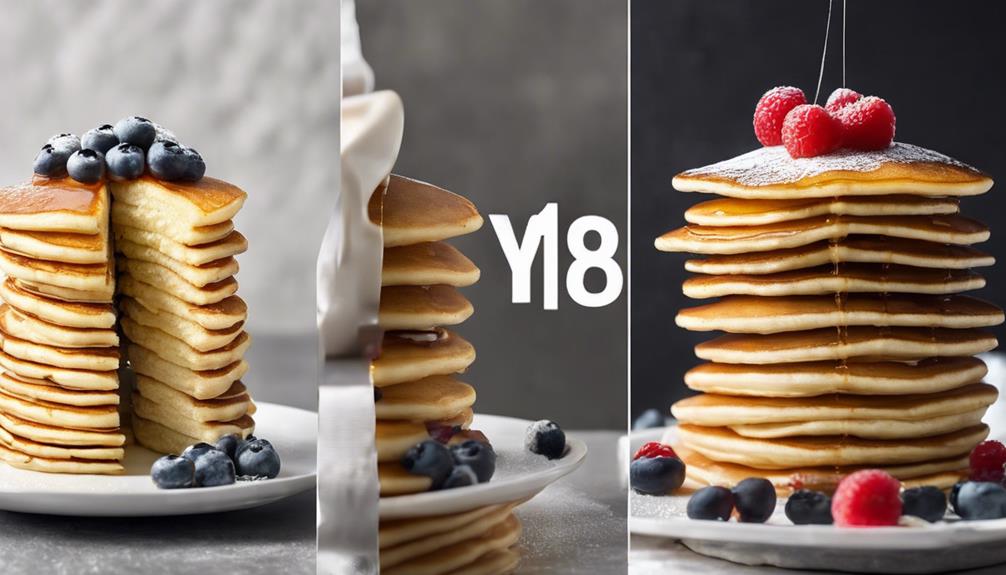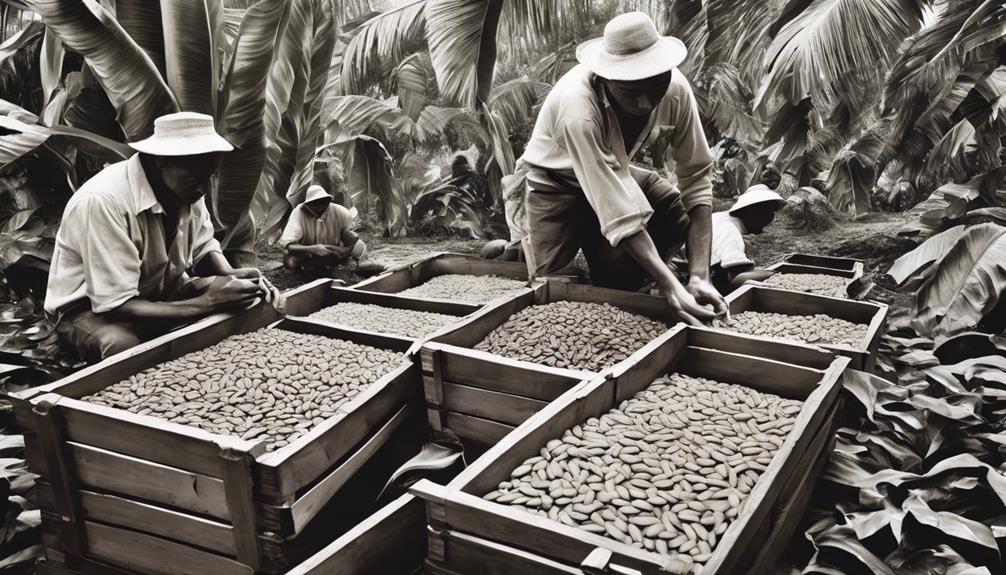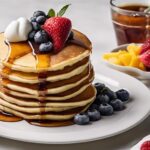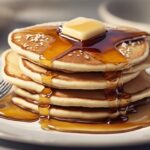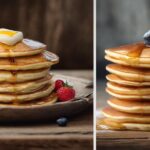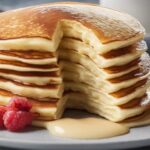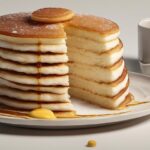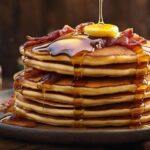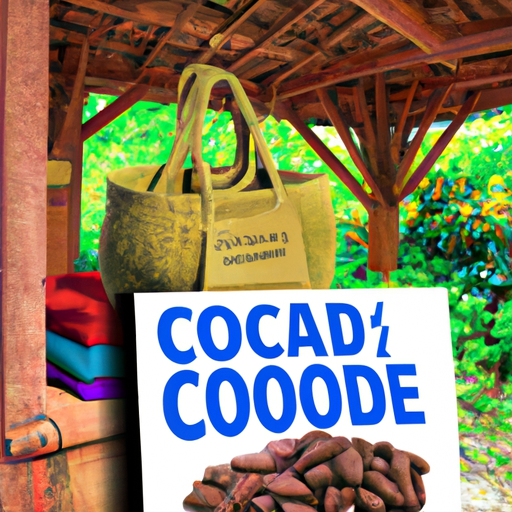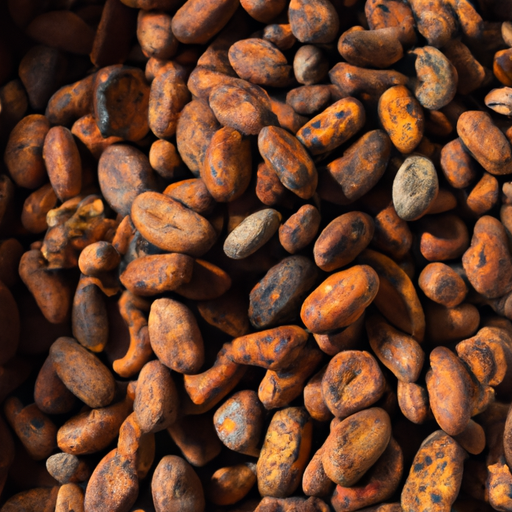When comparing hotcakes and pancakes, the thickness and texture differ greatly. Hotcakes are thicker and denser due to their batter consistency and longer cooking time over low heat. In contrast, pancakes have a lighter batter and are cooked quickly at higher temperatures, resulting in a fluffier texture. Both are versatile with various toppings like butter, syrup, fruits, nuts, whipped cream, and chocolate chips. Additionally, American pancakes are wider and fluffier, whereas European hotcakes are smaller, thicker, and come in diverse shapes. These distinctions provide unique culinary experiences at breakfast tables worldwide.
Key Takeaways
- Hotcakes are denser and thicker than pancakes due to batter consistency and cooking methods.
- Pancakes are lighter and fluffier, cooked quickly at high heat in a skillet.
- Hotcakes are cooked on a griddle slowly for uniform browning, resulting in a denser texture.
- Toppings for both include butter, syrup, fruits, nuts, and unique fillings like savory cheese for hotcakes.
- Hotcakes and pancakes have regional variations in size, shape, and flavors, catering to diverse culinary preferences.
Thickness Differences
Why are hotcakes typically thicker than traditional pancakes?
Hotcakes, also known as flapjacks or griddlecakes, stand out for their substantial thickness compared to the thinner and fluffier pancakes many are accustomed to. The key to understanding this difference lies in the batter consistency and cooking method.
Hotcake batter tends to be denser, containing ingredients like eggs, sugar, and baking powder that contribute to a more significant texture. Additionally, hotcakes are often cooked over lower heat for a longer period, allowing them to rise and develop a thicker profile.
On the other hand, pancakes have a lighter batter and are cooked quickly at higher temperatures, resulting in a thinner and more delicate final product.
The thickness disparity between hotcakes and pancakes plays a vital role in determining their overall taste and mouthfeel, with hotcakes offering a heartier eating experience while pancakes provide a lighter, airier sensation.
Cooking Methods Comparison
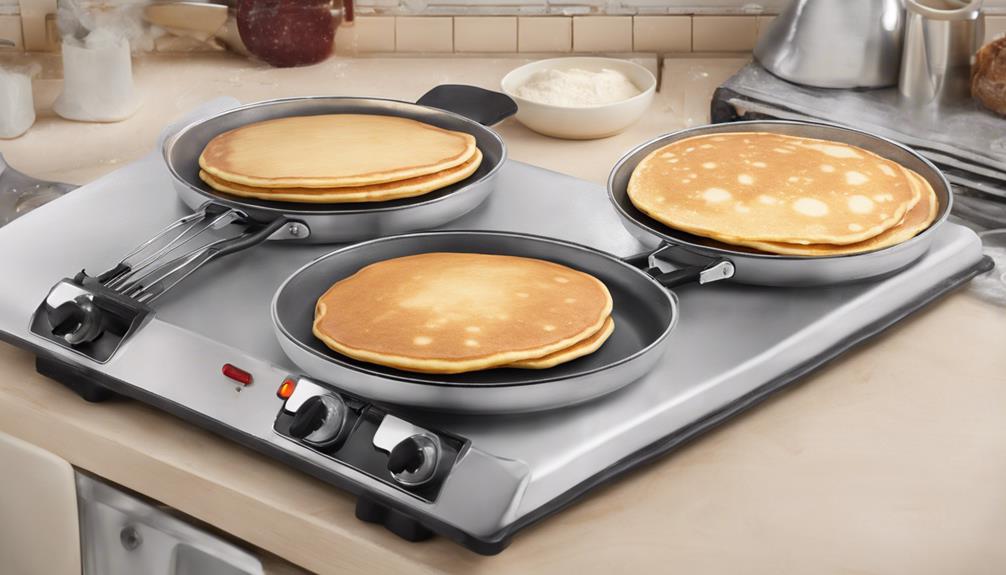
Comparing the cooking methods of hotcakes and pancakes reveals distinct differences in techniques and outcomes. When cooking pancakes, you typically use a skillet or frying pan, giving you more control over the process. This means you can adjust the temperature to achieve your desired texture and level of browning.
On the other hand, hotcakes are often cooked on a griddle or flat surface to guarantee a uniform, golden-brown color throughout. Hotcakes may take longer to cook compared to pancakes as they need more time to reach the desired thickness and fluffiness.
The cooking method for hotcakes tends to result in a denser texture, while pancakes are known for their lighter and fluffier consistency. So, whether you're in the mood for a traditional pancake or a hearty griddle cake, understanding the different cooking methods will help you achieve the perfect outcome every time.
Toppings and Variations
When considering toppings and variations for hotcakes and pancakes, the choices can range from traditional options like butter and syrup to more creative additions such as fruits, nuts, and chocolate. Toppings play a significant role in enhancing the flavor of these breakfast treats.
From the classic combination of butter melting over a warm pancake to the sweetness of maple syrup drizzled on hotcakes, the possibilities are endless. For those craving a more indulgent experience, whipped cream and chocolate chips can be delightful toppings.
Variations extend beyond toppings and can include unique fillings like savory cheese or vegetables incorporated into the batter. Syrups also play an essential role in adding a burst of flavor; whether it's the richness of maple syrup, the fruity sweetness of berry syrups, or the decadence of chocolate syrup, each option brings a different dimension to hotcakes and pancakes.
American Pancakes Characteristics
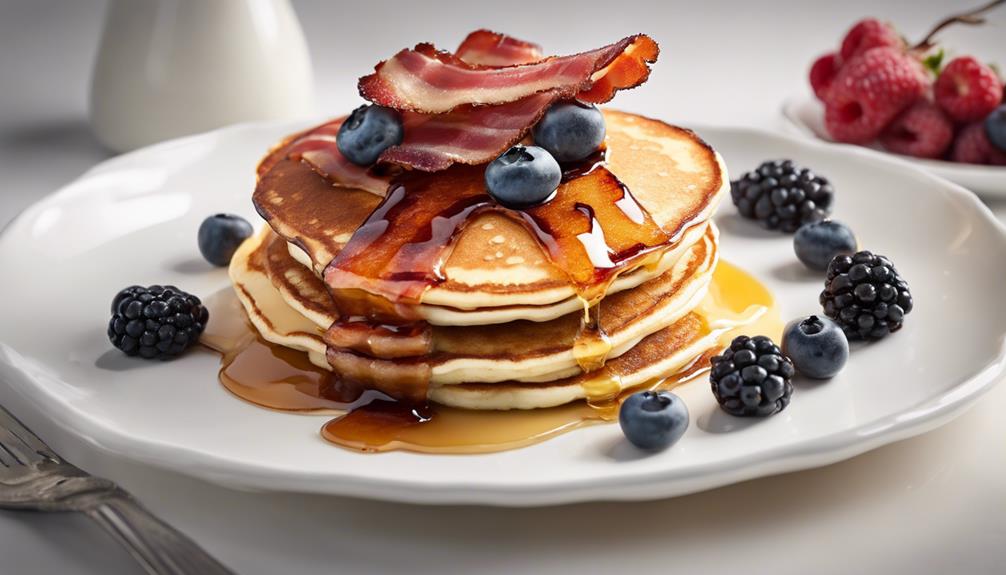
American pancakes are known for their fluffy texture and round shape. They're made with a batter that includes eggs, flour, milk, sugar, and leavening agents.
Toppings like butter, syrup, fruits, nuts, or chocolate are often added to enhance their flavor.
Size Difference
When discussing the size difference between hotcakes and pancakes, it becomes evident that American pancakes tend to be wider and fluffier compared to hotcakes. American pancakes are known for their larger size, often served as a single portion, while hotcakes are typically smaller and denser. The size disparity between the two can vary based on the recipe and cooking method employed. Below is a comparison table highlighting the key differences in size between American pancakes and hotcakes:
| Size | American Pancakes | Hotcakes |
|---|---|---|
| Diameter | Wider | Smaller |
| Thickness | Fluffier | Thicker |
| Serving | Larger portions | Smaller portions |
This table visually represents the contrasting characteristics in size between American pancakes and hotcakes.
Ingredients Variation
In crafting American pancakes, the key lies in the precise combination of flour, eggs, milk, sugar, and leavening agents for that signature fluffy texture and slight sweetness. When making American pancakes, consider these key factors:
- Thicker Batter: Unlike other pancake varieties, American pancakes have a thicker batter consistency, which contributes to their fluffy texture.
- Buttermilk or Yogurt: Ingredients like buttermilk or yogurt can be added to enhance the flavor and texture of American pancakes.
- Cooking Method: American pancakes are often cooked on a griddle or nonstick pan to achieve a golden-brown exterior.
- Sweet Flavor: Known for their slightly sweet flavor, American pancakes are a delightful treat for breakfast or brunch.
European Hotcakes Distinctions
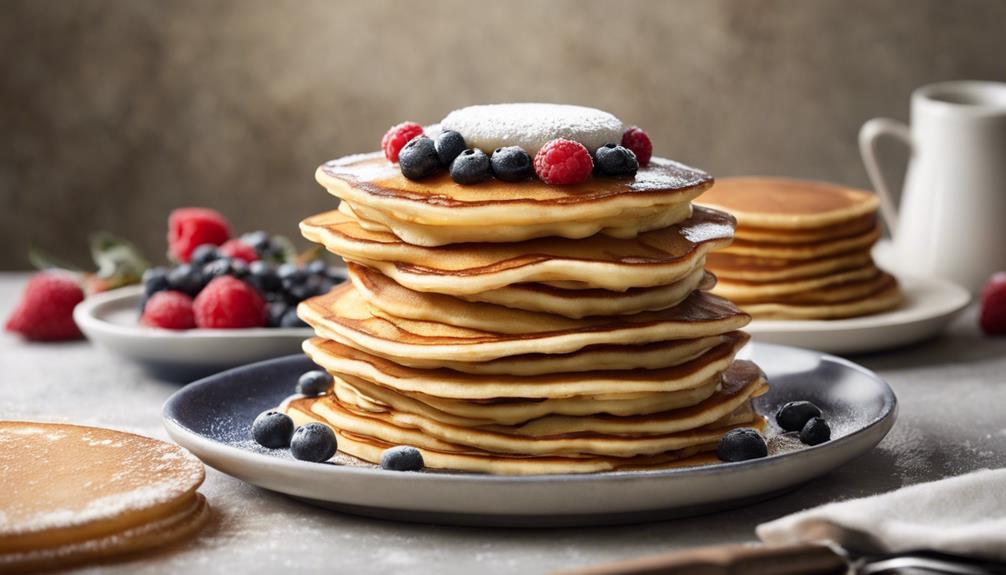
Characterized by their substantial thickness and longer cooking duration, European hotcakes present a distinct contrast to American pancakes. European hotcakes often have a denser texture, providing a heartier eating experience. These hotcakes are commonly enjoyed with a variety of toppings such as fruit, syrup, or whipped cream, adding layers of flavor to each bite. In Europe, hotcakes come in various sizes and shapes, reflecting regional preferences and traditions. What sets European hotcakes apart is their versatility; they can be served as a sweet treat with sugary toppings or as a savory dish paired with ingredients like cheese or herbs.
| European Hotcakes | Distinctions |
|---|---|
| Thickness | Thicker than American pancakes, offering a more substantial bite |
| Cooking Duration | Cooked longer to achieve a denser texture, enhancing the overall taste |
| Toppings | Often served with fruit, syrup, or whipped cream, adding sweetness to the dish |
| Size and Shape | Varies depending on the region, showcasing diverse cultural influences |
| Sweet or Savory | Enjoyed in Europe both as a sweet dessert and a savory meal, catering to all tastes |
Global Interpretations of Pancakes
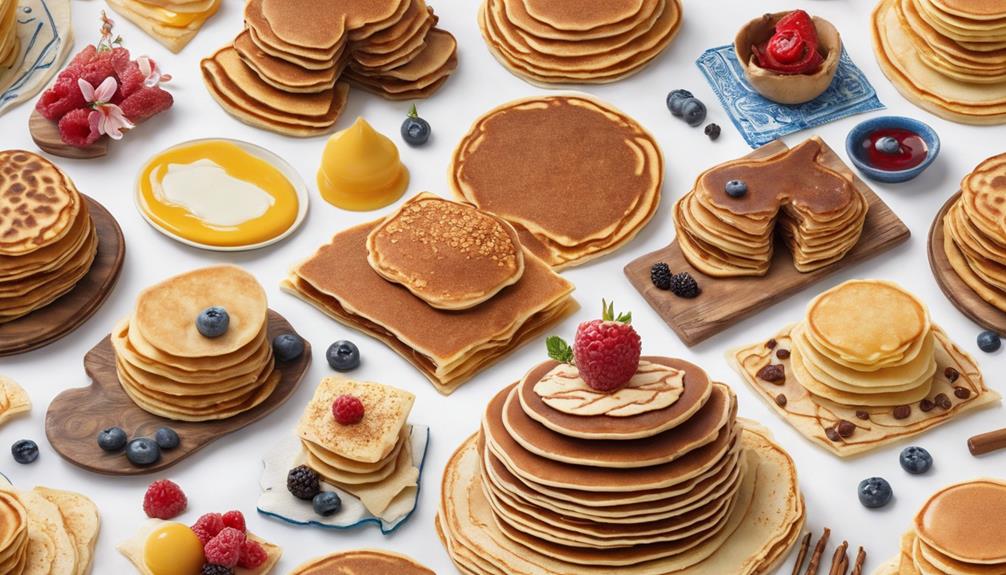
Exploring pancake variations worldwide reveals a rich tapestry of flavors and textures that cater to diverse culinary preferences. When it comes to global interpretations of pancakes, you can find a delightful array of unique styles that showcase the creativity and traditions of different cultures. Here are some intriguing examples to tantalize your taste buds:
- Japanese Hotcakes: These fluffy, thick pancakes are a popular choice in Japan, known for their airy texture and sweet flavor. Often served with fruits and whipped cream, Japanese hotcakes offer a delightful twist on the classic pancake.
- Mexican Hotcakes: In Mexico, hotcakes are often made with cornmeal or masa harina, giving them a distinctively earthy taste. They're commonly served with a drizzle of honey or syrup, creating a delicious blend of sweet and savory flavors.
- Swedish Pancakes: Swedish pancakes, also known as 'plättar,' are thin and delicate crepe-like pancakes that are typically enjoyed with lingonberry jam and a sprinkle of powdered sugar. These pancakes are perfect for a cozy breakfast or a special treat.
- Korean Pancakes: In Korea, pancakes known as 'jeon' are made with various ingredients like seafood, vegetables, or kimchi, creating a savory and crispy pancake that's often enjoyed as a side dish or appetizer.
Crepes, Dosas, and Blinis
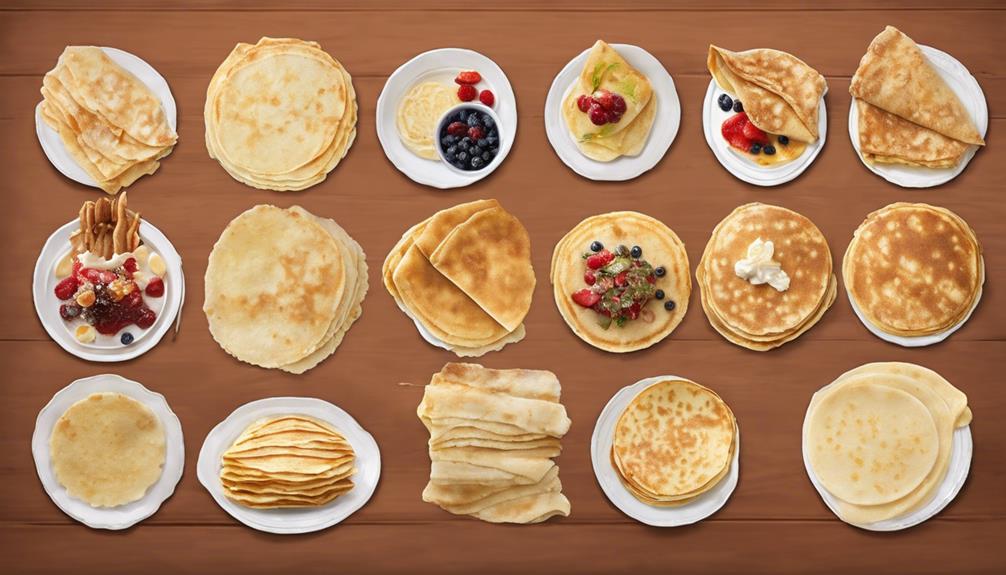
Crepes, dosas, and blinis each bring a distinct twist to the world of pancakes.
Crepes are delicate, thin pancakes that can be filled with a variety of sweet or savory fillings.
Dosas, on the other hand, are Indian pancakes made from different grains and pulses, often paired with a flavorful potato filling.
Blinis, a Russian specialty, are savory buckwheat pancakes commonly served with fish or meat toppings.
Crepes Vs Dosas
When comparing crepes and dosas, it's fascinating to note the distinct cultural and culinary differences in these thin pancakes.
- Origin: Crepes originate from France, while dosas are a traditional dish in India.
- Ingredients: Crepes are typically made from wheat flour, whereas dosas are made from rice, semolina, or pulses.
- Fillings: Crepes can be filled with sweet or savory ingredients, while dosas are commonly served with a potato filling and chutneys.
- Presentation: Crepes are often rolled or folded, while dosas are usually served flat or folded into a triangular shape.
These differences in origin, ingredients, fillings, and presentation make crepes and dosas unique and delicious in their own ways.
Blinis Characteristics
Comparing the cultural and culinary distinctions of crepes and dosas to the unique characteristics of Blinis, one encounters a flavorful journey through the diverse world of thin pancakes. Blinis, known as Russian pancakes, are traditionally made with buckwheat flour, giving them a slightly tangy flavor from the fermentation process. These savory delights are often served with luxurious toppings like caviar, smoked salmon, or sour cream, making them a popular choice for appetizers or snacks in Russian cuisine. Unlike their American pancake counterparts, Blinis are smaller in size but pack a punch of flavor in each bite. The blend of textures and tastes in Blinis showcases the versatility of thin pancakes, making them a delightful treat for any occasion.
| Characteristics | Blinis |
|---|---|
| Origin | Russia |
| Flour Used | Buckwheat |
| Toppings | Caviar, smoked salmon, sour cream |
| Size | Smaller than American pancakes |
Flavors and Textures Exploration
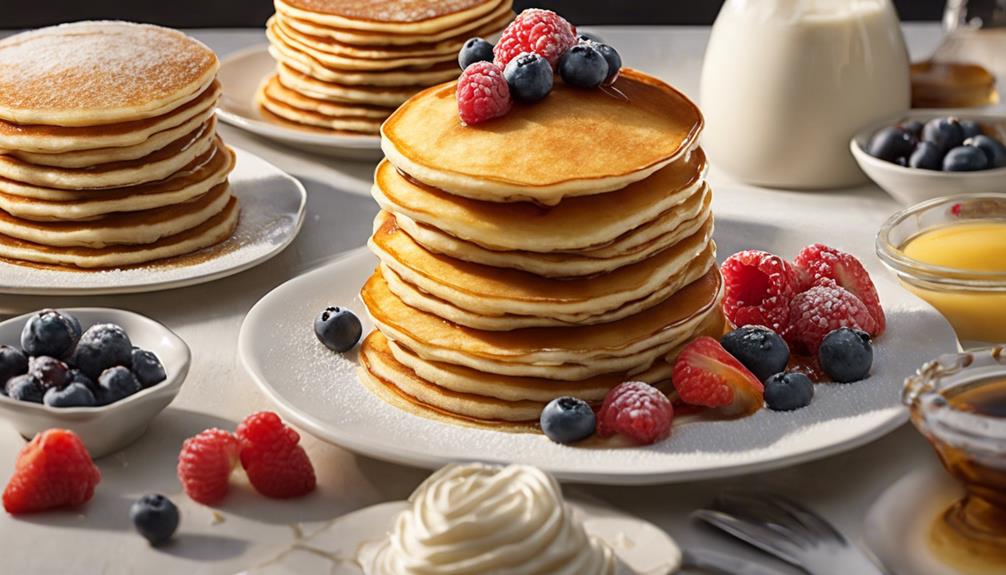
Exploring the diverse flavors and textures of hotcakes and pancakes reveals a fascinating culinary contrast. When comparing the two, there are noticeable differences that cater to various preferences:
- Texture: Hotcakes are known for their denser and thicker consistency, resembling a cake-like texture that provides a hearty bite. On the other hand, pancakes are wider and fluffier, offering a lighter and more delicate mouthfeel that many enjoy.
- Flavor Profile: Hotcakes often boast a slightly sweeter flavor compared to pancakes, making them a favorite among those who prefer a richer taste. In contrast, pancakes tend to have a more neutral flavor, allowing for versatility in pairing with different toppings.
- Cooking Time: Pancakes are quick to cook due to their thin nature, making them a convenient choice for a fast breakfast option. Hotcakes, with their thicker composition, may require a bit more time on the griddle for thorough cooking.
- Regional Preferences: The texture of hotcakes can vary regionally, with some areas opting for a more cake-like consistency while others prefer the fluffy pancake style. Experimenting with different recipes can lead to a delightful exploration of these variations in flavors and textures.
Beloved Breakfast Staple Varieties
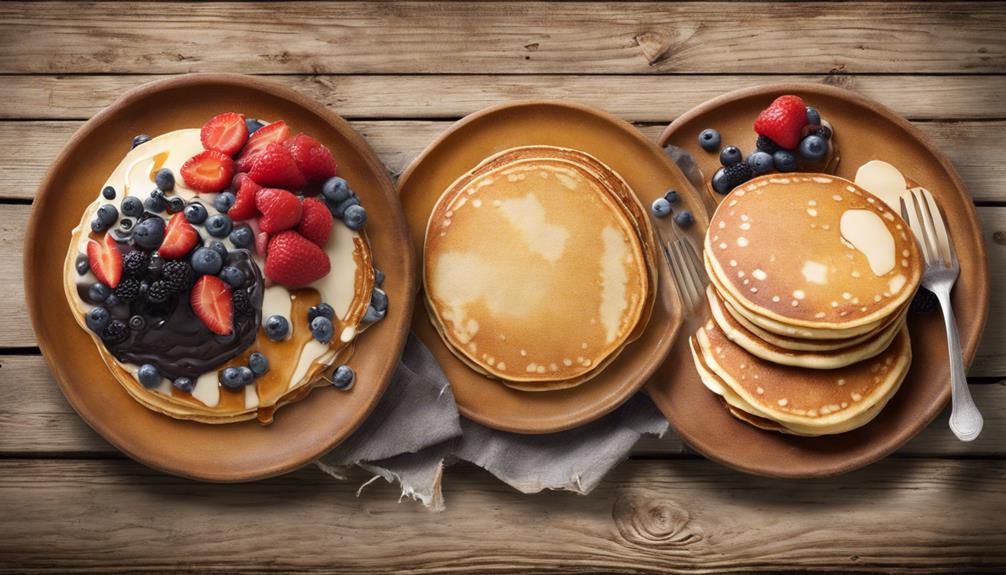
Amidst the array of breakfast options, hotcakes and pancakes stand out as beloved staples enjoyed by many. Hotcakes, known for being thicker and denser than traditional pancakes, offer a heartier breakfast choice.
Surprisingly, McDonald's played a significant role in popularizing the term 'hotcakes' for their pancake offerings in the US, creating a unique marketing distinction.
When comparing hotcakes to pancakes, one may notice that hotcakes often have a slightly different texture due to being cooked longer, resulting in a browner surface. Additionally, various regions worldwide, such as Europe, have their own versions of hotcakes that differ from the American pancake, showcasing the diversity of breakfast staples globally.
The term 'sell like hotcakes' isn't without merit, as hotcakes are associated with quick sales and high demand, emphasizing their widespread popularity.
Whether you prefer hotcakes or pancakes, these breakfast classics continue to be cherished by many for their comforting flavors and versatility.
Frequently Asked Questions
Why Are They Called Hotcakes Instead of Pancakes?
They're called hotcakes instead of pancakes because the term 'hotcakes' is often used to convey freshness or a thicker, fluffier texture. It's just a regional or marketing twist on the same delicious breakfast item.
What's the Difference Between Cakes and Pancakes?
When I compare cakes to pancakes, I notice how cakes are sweet delights reserved for special occasions, while pancakes are comforting morning treats. The variance lies in their purpose; one celebrates, the other nurtures.
Are Mcdonald's Hotcakes Just Pancakes?
I believe McDonald's hotcakes are basically their take on pancakes. They're thick, fluffy, and served with butter and syrup. While they may have slight variations, the term 'hotcakes' might just be a marketing strategy.
What's the Difference Between Pancakes and Flapjacks?
When it comes to pancakes and flapjacks, the key difference lies in regional variations and ingredients. In the UK, flapjacks are oat-based treats, while in the US, they're often used interchangeably with pancakes.
What Are the Main Variations Between Hotcakes and Pancakes?
The hot cake and pancake differences lie mainly in their thickness and texture. Hot cakes tend to be thicker and fluffier, while pancakes are typically thinner and more delicate. Additionally, hot cakes often include extra ingredients like baking powder or buttermilk, giving them a slightly different flavor compared to traditional pancakes.
Conclusion
To sum up, while hotcakes and pancakes may seem similar, there are key differences that set them apart. For instance, hotcakes are typically thicker and fluffier than pancakes, and they're often cooked using different methods.
Surprisingly, in the United States, pancakes are a beloved breakfast staple, with the average American consuming about 4.5 pounds of pancakes each year.
Whether you prefer pancakes or hotcakes, they both offer a delicious and satisfying breakfast option.

